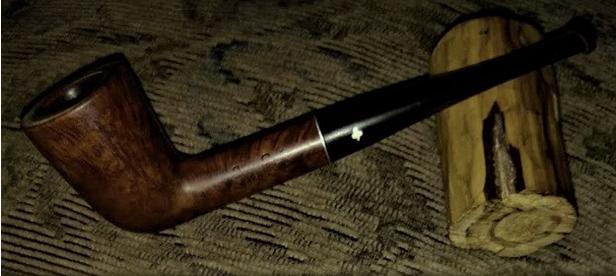Copyright © Reborn Pipes and the Author except as cited
https://www.roadrunnerpipes2k.com/
https://www.facebook.com/roadrunnerpipes/
FOR MY DAD
E. MICHEAL BOUGHTON
2/23/1933-10-16-2018
 my father moved through dooms of love
my father moved through dooms of love
through sames of am through haves of give,
singing each morning out of each night
my father moved through depths of height
— e.e. cummings, “my father moved through dooms of love,” from 50 Poems, 1940
INTRODUCTION
I was going to start with the dedication and for once leave out the opening quote. Then the last stanza of Dylan Thomas’ “Do not go gentle into that good night” came to me. I even had it typed in a few seconds. Upon reflection, however, the idea of Thomas’ great, impassioned cry to his father, there on the sad height, seemed a little too close to my own feelings and therefore by definition selfish. Any notion of beginning with words from Thomas, albeit brilliant and stirring, was belayed by the sudden and vivid recollection of my dad and me having a rare pleasant conversation. The Cold War was raging hotter than ever at the time, and that was more or less what our normal interactions resembled
Out of nowhere, it seemed, the pleasant remembrance filled my mind, from lifetimes ago when I was 16 or so and reading books almost every spare moment I had. I used books back then the way I later turned to alcohol more than I already had, to escape reality, except the books were good for me. I could see the two of us, my dad and me, standing in the entryway to the house, golden-orange beams of late afternoon sunlight filtering through the windows. My knapsack was stuffed, as tight as an overfilled laundry machine, with schoolbooks and other implements of learning, while cradled in my arms were about five diverse and serious reads I had bought for my own pleasure. As my tastes were then and remain now rather eclectic, but with several main themes at the time, there was probably one each classic, sci-fi, fantasy, quirky crime fiction like Elmore Leonard’s Mr. Majestyk or anything having to do with spies by The Master, John le Carré, and of course someone’s, anyone’s, biography.
My dad made a point of coming out of his room and stopping me to talk, the subject of which I’m sure now didn’t make any difference to him. He saw the load of new books I was holding and asked what I was reading those days. I just handed them to him so that he could see for himself. He was impressed, but what he said really struck me in a good way, as I had been thinking more or less the same thing. He asked if I read any poetry.
All that came to mind back then were two poems, starkly different in style, that now seem to me interesting examples of poetry to compare and contrast. But worry not, I won’t try it here! They were Thomas’ perhaps best-remembered work that, years later, I compared to my dad in an essay I wrote for the English Comp AP course I took at NMSU in Las Cruces, and Alfred, Lord Tennyson’s “Tears, Idle Tears.” While the former was and remains a favorite example of the artform I consider the highest to which any writer can aspire, I used to make my friends laugh with my lachrymose recitations of the latter. I didn’t even consider the obvious, that my memorization of both and occasional sensitive spoken interpretations of Thomas’ masterpiece yet crass and venomous performances of Tennyson’s work of equal value were reflections of the mirror I gazed into every time I spoke his beautiful, insightful words in immature lampoonery.
My dad is the person who turned me on to e.e. cummings, and to him I now owe the fact I remembered the lines from the opening quote. In fact I owe so much more to the man, parts of it good and others not so. But all things considered, I turned out okay. Now I miss him more than ever and feel his irrecoverable absence like a horrible sting.
At any rate, this blog is about a Kaywoodie Super Grain Dublin #08 that is almost as old as my dad was. The left shank nomenclature approximates its age to the 1930s with the placement of SUPER GRAIN above KAYWOODIE, and the right shank imprints of IMPORTED BRIAR and 08 narrow the timeline to 1935-1938. Every part of this beautiful pipe is original, including the stem and patented Drinkless stinger with the word etched into it. If this pipe was around in 1936, its price would have been $5. But more than the absence of the usual four-digit shape number connected with Kaywoodie pipes from this period, I’m having trouble imagining my dad no bigger than a boy of five.
RESTORATION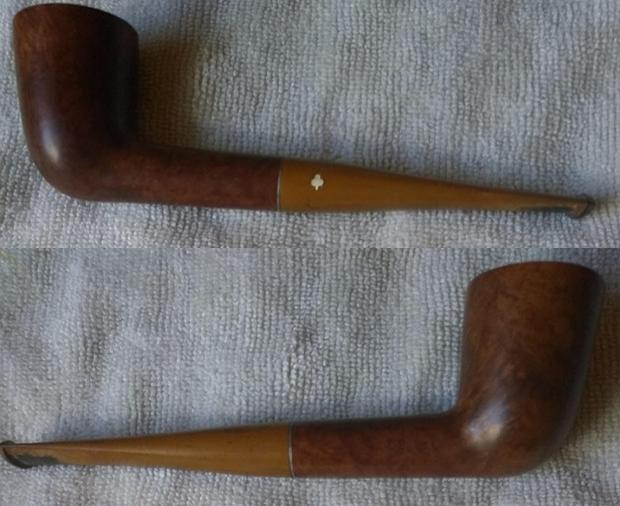
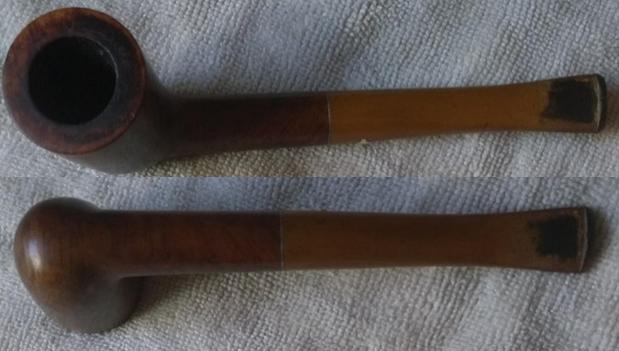
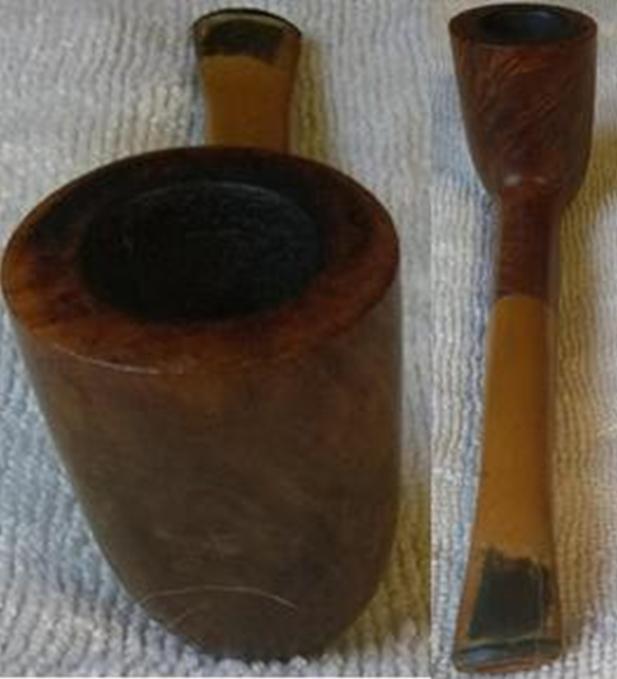
 This Super Grain was in amazing condition for a pipe well into its 80s! The only problems presenting were normal rim char, well-maintained cake buildup and the almost mandatory, for Kaywoodies, mis-clocked stem. Something told me that might more or less fix itself before the project was complete.
This Super Grain was in amazing condition for a pipe well into its 80s! The only problems presenting were normal rim char, well-maintained cake buildup and the almost mandatory, for Kaywoodies, mis-clocked stem. Something told me that might more or less fix itself before the project was complete.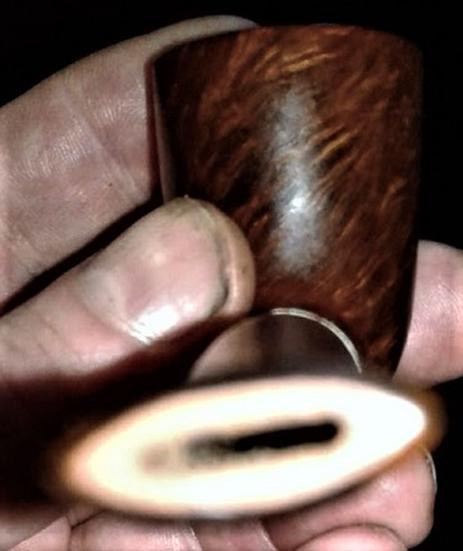 I dunked the stem in an OxiClean bath and planned on letting it stay there longer than usual, given that the old Vulcanite was almost solid yellow-green, whatever that color is called. I also had errands to run. When I returned home a couple of hours later, I removed the stem from the nasty, dark bathwater, ran a pipe cleaner through the airhole, rinsed and scrubbed it with my thumbs and fingers and dried it off. A little piece of 320-grit paper made it solid black again. [I restored this pipe not long ago, but as I noted in my last blog, I had not yet learned how effective going straight to 1000-grit paper can be. That’s where I’ll start from now on. This time I lucked out.]
I dunked the stem in an OxiClean bath and planned on letting it stay there longer than usual, given that the old Vulcanite was almost solid yellow-green, whatever that color is called. I also had errands to run. When I returned home a couple of hours later, I removed the stem from the nasty, dark bathwater, ran a pipe cleaner through the airhole, rinsed and scrubbed it with my thumbs and fingers and dried it off. A little piece of 320-grit paper made it solid black again. [I restored this pipe not long ago, but as I noted in my last blog, I had not yet learned how effective going straight to 1000-grit paper can be. That’s where I’ll start from now on. This time I lucked out.]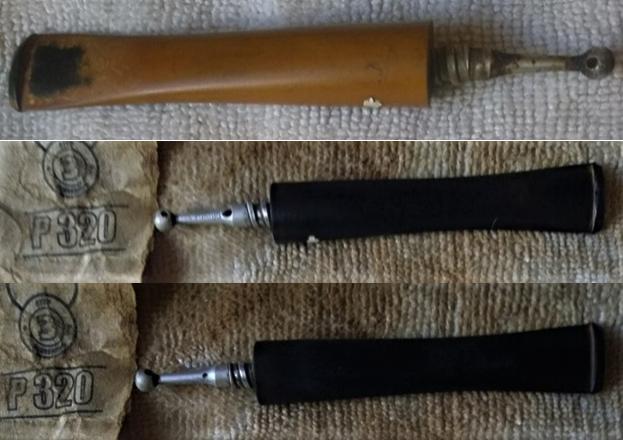 I continued work on the stem and started on the rim burn with a soft green Brillo pad that brought out a soft shine on the stem, which may very well be the first one I’ve come across with no scratches that needed removing, much less tooth chatter or even a chink in the lip, top or bottom. For the rim, the Brillo was a beginning.
I continued work on the stem and started on the rim burn with a soft green Brillo pad that brought out a soft shine on the stem, which may very well be the first one I’ve come across with no scratches that needed removing, much less tooth chatter or even a chink in the lip, top or bottom. For the rim, the Brillo was a beginning.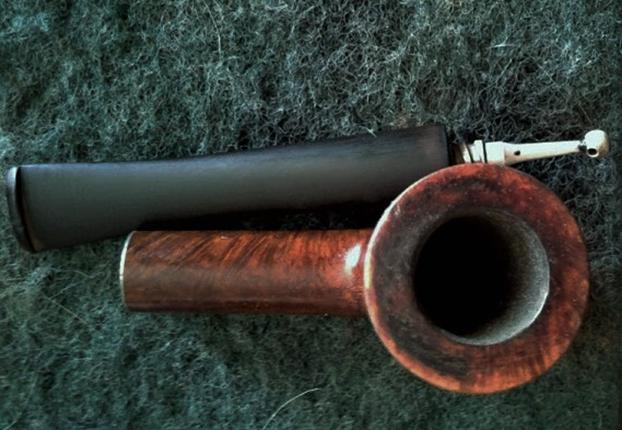 Finishing the stem with 400-, 600- and 1000-grit papers followed by a full run of micro mesh from 1500-12000, I turned to a piece of super fine “0000” steel wool for the remainder of black on the rim.
Finishing the stem with 400-, 600- and 1000-grit papers followed by a full run of micro mesh from 1500-12000, I turned to a piece of super fine “0000” steel wool for the remainder of black on the rim. Again, not being aware of how great a job 1000-grit paper does, I continued work on the rim with 320-grit. Everything worked out in the end, but really, I had no idea how much extra work I’ve been doing! In fact, I understand now how bad was the habit into which I had fallen.
Again, not being aware of how great a job 1000-grit paper does, I continued work on the rim with 320-grit. Everything worked out in the end, but really, I had no idea how much extra work I’ve been doing! In fact, I understand now how bad was the habit into which I had fallen. Smoothing the rim with 400- to 1000-grit papers, and in the process returning the grain to normal since I didn’t use the least abrasive grade in the first place, I finished that stage in anticipation of a spot stain there after micro meshing. In the meantime, I reamed the chamber and sanded with 150- and 220-grit papers. That was supposed to be just the start, but the mature and venerable Dublin was so loved and respected by its previous (and, I think, only other) owner that the chamber wall was baby smooth to the touch.
Smoothing the rim with 400- to 1000-grit papers, and in the process returning the grain to normal since I didn’t use the least abrasive grade in the first place, I finished that stage in anticipation of a spot stain there after micro meshing. In the meantime, I reamed the chamber and sanded with 150- and 220-grit papers. That was supposed to be just the start, but the mature and venerable Dublin was so loved and respected by its previous (and, I think, only other) owner that the chamber wall was baby smooth to the touch. I had forgotten the wonderful quality of briar and other woods to reacquire their original hue after being sanded down to a lighter shade and then worked back up with finer and finer grades of paper. Therefore I was surprised but happy to see the lovely, mottled, somewhat leopard-like spots and blotches on the rim, and the natural shiny dark brown color that matched the whole surface, with the following full micro mesh of the stummel. The thought occurred to me that when the pipe was first crafted, no stain might have been applied.
I had forgotten the wonderful quality of briar and other woods to reacquire their original hue after being sanded down to a lighter shade and then worked back up with finer and finer grades of paper. Therefore I was surprised but happy to see the lovely, mottled, somewhat leopard-like spots and blotches on the rim, and the natural shiny dark brown color that matched the whole surface, with the following full micro mesh of the stummel. The thought occurred to me that when the pipe was first crafted, no stain might have been applied.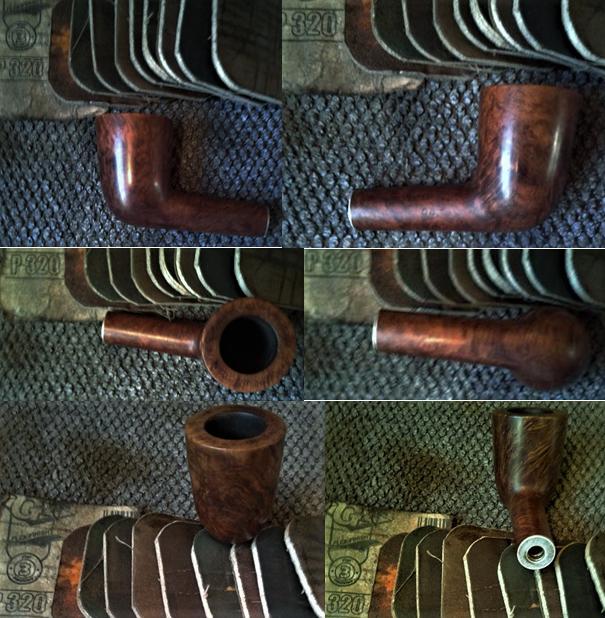 The only thing left to do was retort the pipe. This step further revealed that whoever was the guardian of this magnificent specimen of pipehood was also good enough to enjoy it quite often. Four test tubes full of alcohol had to be boiled through the inner passageways from the lip of the stem to the top of the chamber before it was almost clear.
The only thing left to do was retort the pipe. This step further revealed that whoever was the guardian of this magnificent specimen of pipehood was also good enough to enjoy it quite often. Four test tubes full of alcohol had to be boiled through the inner passageways from the lip of the stem to the top of the chamber before it was almost clear.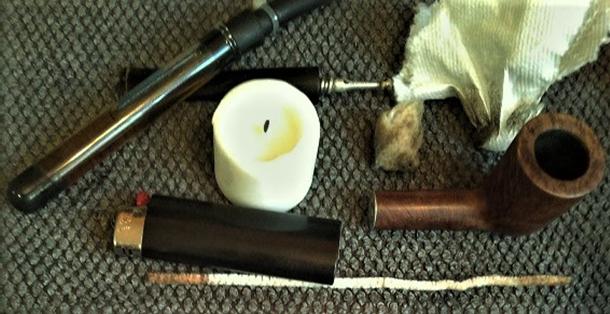 Don’t take this as bragging because I know I had nothing to do with the skill and care that went into the very vintage Kaywoodie’s genesis – all I did was make it show again – but the color and shine of the wood were perfect as-is at that point and, as far as I could see, needed no further help. And so, I didn’t even buff it on the wheel for the first time in my experience with pipes. But to return the stem to the same sheen, I buffed it on the electric wheel with White and Red Tripoli.
Don’t take this as bragging because I know I had nothing to do with the skill and care that went into the very vintage Kaywoodie’s genesis – all I did was make it show again – but the color and shine of the wood were perfect as-is at that point and, as far as I could see, needed no further help. And so, I didn’t even buff it on the wheel for the first time in my experience with pipes. But to return the stem to the same sheen, I buffed it on the electric wheel with White and Red Tripoli.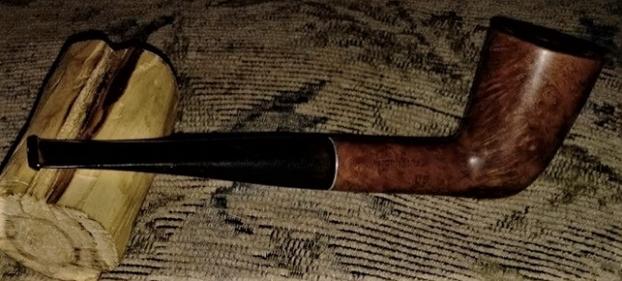
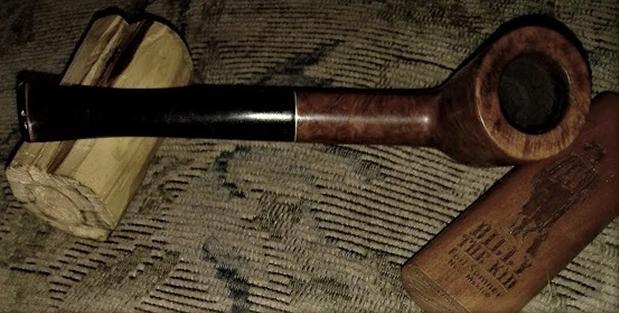


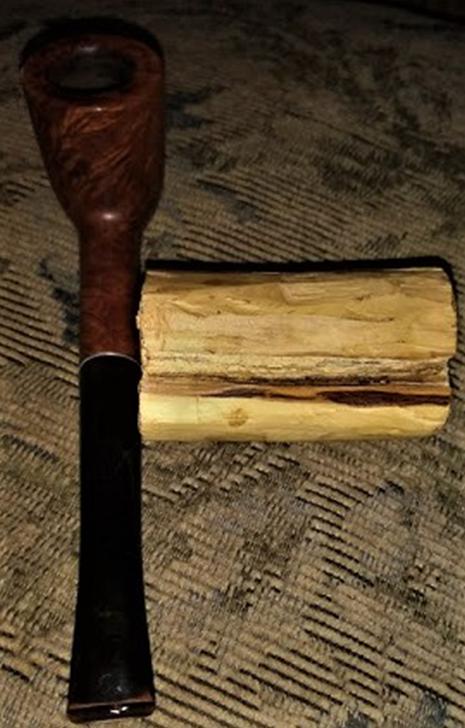
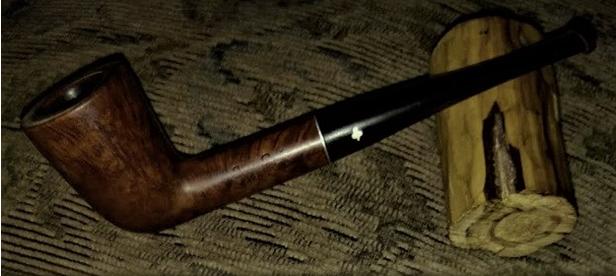
 Oh, and I just remembered the other two aspects of the pipe I noted earlier but almost forgot to address, because, as with some other aspects of the restoration, I forgot to snap a shot of one and deleted the other considering its apparent superfluousness. The stinger that was misaligned at first indeed did correct itself, with a small nudge, or firm but careful twist, rather, from me. And then there was my mention of the almost incredible fact that the Drinkless stem, with its four-holed ball at the end to be inserted into the shank – which ball, by the way, resembles an antique naval mine with its detonator legs removed, or is it just me? – was etched with the word DRINKLESS.
Oh, and I just remembered the other two aspects of the pipe I noted earlier but almost forgot to address, because, as with some other aspects of the restoration, I forgot to snap a shot of one and deleted the other considering its apparent superfluousness. The stinger that was misaligned at first indeed did correct itself, with a small nudge, or firm but careful twist, rather, from me. And then there was my mention of the almost incredible fact that the Drinkless stem, with its four-holed ball at the end to be inserted into the shank – which ball, by the way, resembles an antique naval mine with its detonator legs removed, or is it just me? – was etched with the word DRINKLESS. 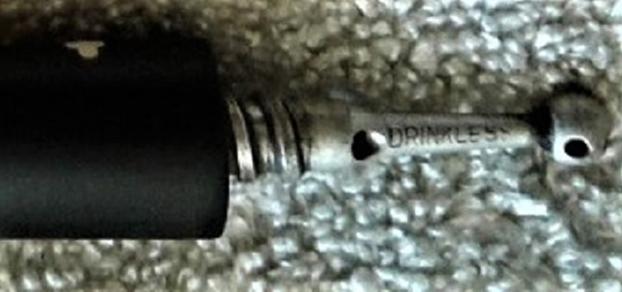 The shot above, enhanced by photo editing software with which I am at last becoming more adept, illustrates both the screwed-up (pun intended) aspect of the stinger and the etching. Worth mentioning, to me at least, are Pipephil’s details that include such tidbits as these: the original Drinkless patent (No. 213598) had a push-in design that was used from 1924-1931; the updated version with the same patent number became the longer screw-in and is stated as being used from 1929 until as recently as the 1960s, and in 1932 the SynchroStem patent was granted in favor of the Drinkless. The newer Drinkless stingers also had the words “REG. NO. 213598 etched under the Drinkless designation, although I didn’t look closely enough or take a good enough photo to show it.
The shot above, enhanced by photo editing software with which I am at last becoming more adept, illustrates both the screwed-up (pun intended) aspect of the stinger and the etching. Worth mentioning, to me at least, are Pipephil’s details that include such tidbits as these: the original Drinkless patent (No. 213598) had a push-in design that was used from 1924-1931; the updated version with the same patent number became the longer screw-in and is stated as being used from 1929 until as recently as the 1960s, and in 1932 the SynchroStem patent was granted in favor of the Drinkless. The newer Drinkless stingers also had the words “REG. NO. 213598 etched under the Drinkless designation, although I didn’t look closely enough or take a good enough photo to show it.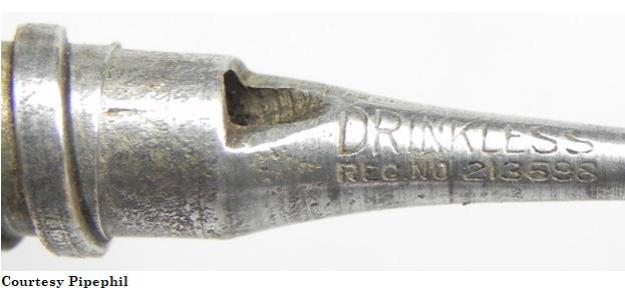 But – and here is where all the confusion reaches its zenith – Kaywoodie decided to move toward a three-hole stinger at an “indeterminate date.”
But – and here is where all the confusion reaches its zenith – Kaywoodie decided to move toward a three-hole stinger at an “indeterminate date.”
Ah, the joys of dating a pipe! The Super Grain in this blog, however, is a definite match for the period 1935-1938. I’m beginning to think pipes, like some people, should only be enjoyed, never dated. 😊
CONCLUSION
My dad was an avid pipe smoker until my mother, sister and two step-sisters put an end to that. I say they did it, but the sad truth I still regret to this day is that I let them drag me into the brouhaha: the incessant reminding him, every time he sat down to relax and light up, of what the ninth U.S. Surgeon General, a well-meaning and for the most part dead-on man by the name of Luther L. Terry, MD, had reported two years after I was born, to wit, that smoking tobacco tends to have “an adverse impact…[on] health worldwide,” and the steady buildup to more snide comments such as the amount of time every use of tobacco deprived people of life (not counting the comments about second-hand smoke). By the end, the unwarranted and downright cruel attacks on my dad by all of us had escalated to all-out war. In the end, my dad surrendered and vowed to stop smoking his impressive collection of the beautiful briar works of art and implements of deep contemplation.
In my defense, this was all going down around 1968, when I was a mere lad of six. But I can still picture the vast assortment of mostly smooth, easy bent billiards he favored, though there were some that were sandblasted also, and even more interesting, longer, straight ones I now understand were Canadians or others of that family. In my mind I can see them now with such clarity that, given the experience I have had in some of the intervening years, I am positive they were all created by the greatest English makers of those times and these.
In other words, my dad was not keen on American brands the likes of Kaywoodie. But he was a man whose tastes changed, like most of us, and I suspect that had we left him alone to his peaceful enjoyment of his pipes, his collection would have evolved. If only we had not badgered him into submission, if only he had stood his ground and just said no, if only we had not grown apart – I might very well have given him this pipe for his last birthday. And I’m sure he would have lived just as long as the 85 years he lasted before dementia and other non-smoking-related problems took him.
In a letter, Dylan Thomas described his approach to writing this way: “I make one image—though ‘make’ is not the right word; I let, perhaps, an image be ‘made’ emotionally in me and then apply to it what intellectual & critical forces I possess—let it breed another, let that image contradict the first, make, of the third image bred out of the other two together, a fourth contradictory image, and let them all, within my imposed formal limits, conflict.”
That’s my dad, to a tee. Still, I love him and miss him more now than I did the long years he decided not to communicate with me anymore. So now, as still another great poet wrote, I sound my barbaric yawp.
He wasn’t big on crying, so I’m going to have to stop here.
SOURCES
https://www.poets.org/poetsorg/poem/my-father-moved-through-dooms-love-0
https://genius.com/Dylan-thomas-do-not-go-gentle-into-that-good-night-annotated
https://www.poetryfoundation.org/poems/45384/the-princess-tears-idle-tears
http://www.pipephil.eu/logos/en/logo-kaywoodie-2.html
https://pipedia.org/wiki/Kaywoodie_Shape_Numbers
https://pipedia.org/index.php?title=Collector%27s_Guide_to_Kaywoodie_Pipes&mobileaction=toggle_view_mobile#1936_Kaywoodie_Shape_Numbers_and_Descriptions
http://www.pipephil.eu/logos/en/infos/kaywoodie-drink.html
http://www.pipephil.eu/logos/en/infos/kaywoodie-synchro.html
http://www.pipephil.eu/logos/en/infos/kaywoodie-3stinger.html

